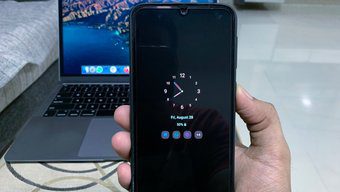Before you get used to the default display settings on your Mac, you should fine-tune your Mac’s display. Whether it’s creative work or watching videos, the screen should produce colors and contrast as per your preference. And for that, you’ll have to tinker around with your Mac’s display settings. We’ll share the different tweaks you can make to your Mac’s display settings to get the desired quality of visuals.
1. Switching Dark Mode On and Off
Many iPhone users switch dark mode on, whether to reduce the strain on their eyes or because they prefer the look. And if your Mac runs macOS Sierra 10.12.4 or later, you can switch this feature. To turn dark mode on, follow these steps. Step 1: Click on the Apple logo in the top-left corner of your screen and click on System Preferences. Step 2: Select the General icon. Step 3: At the top of this window, next to “Appearance”, select Dark. This applies the Dark theme across the system and apps that support it natively.
2. Change Mac Display Contrast
You can also adjust the contrast on your Mac if you think the colors are overwhelming. Follow these steps to do this. Step 1: Click on the Apple logo in the top-left corner of your screen and click on System Preferences.. When it opens, click on Accessibility. Step 2: On the sidebar, select Display. Step 3: Tick the Increase contrast box. Step 4: After ticking the box, you can control your screen’s contrast with the Display contrast slider at the bottom. Moving this to the right will increase this further while going to the left will decrease it.
3. Inverting Colors (Optional)
If you’re having difficulty seeing texts and visuals on your Mac, you might want to invert the colors. Doing this will give you a black background, making everything else stand out. However, this feature is not really perfect and can deliver a weird interface look. So proceed at your own discord. Inverting your Mac’s colors is a straightforward process and shouldn’t take you long. The steps below will walk you through everything. Step 1: Click on the Apple logo in the top-left corner of your screen and click on System Preferences.. Click on Accessibility. Step 2: Select Display on the left-hand sidebar. Step 3: At the top, you’ll see a box next to “Invert colors”. Tick this. Experiment between the standard color inversion and Classic Invert, which you can activate by ticking the box in the subsection beneath Invert colors. The differences might be subtle, so the best choice is whichever your eyes prefer.
4. Changing Screen Resolution
When you first start using your Mac, everything will show up in the standard resolutions for your device. And while you can zoom in on browsers and documents, it’s not as widely known that you can do likewise with your entire screen by default. Also, when you plug your mac to an external monitor, you’ll need to adjust the display resolution Apple has a feature that allows you to change the screen resolution, which increases the size of everything. To access this: Step 1: Click on the Apple logo in the top-left corner of your screen and click on System Preferences. Then,click on Displays and select the first tab. Step 2: If the section “Resolution:”, make sure that you’ve chosen the circle next to Scaled rather than Default for display. Step 3: In the white box that appears, you’ll see several resolutions. Pick whichever suits your needs best. If you pick the ones closer to the bottom, it’s worth remembering that your Mac might struggle to fit everything onto the screen. However, you’ll see a warning for this – and your device will allow you to either go ahead anyway or change your mind.
5. Enabling Color Filters
If you feel that the colors in the photos and videos aren’t the ones you like, you can caliberate the screen. To do this: Step 1: Click on the Apple logo in the top-left corner of your screen and click on System Preferences.. Next, click Accessibility. Step 2: On the Display subsection, tap on the third tab – titled Color Filters. Step 3: Tick the box next to Enable Color Filters. Step 4: Click on the expandable menu next to “Filter type:” and pick the color filter that fits your needs best. Once you’ve chosen a color filter, you can strengthen or weaken the intensity using the slider at the bottom of the screen.
Make Your Mac Display Look Better
While the standard Mac display settings are good enough for most people, you might need to make changes out of necessity. Alternatively, you may want to switch things up for a little bit. Having read this guide, you have all the tools you need to change your Mac display settings. Give each of them a play-around to see which best fits your tastes. The above article may contain affiliate links which help support Guiding Tech. However, it does not affect our editorial integrity. The content remains unbiased and authentic.























